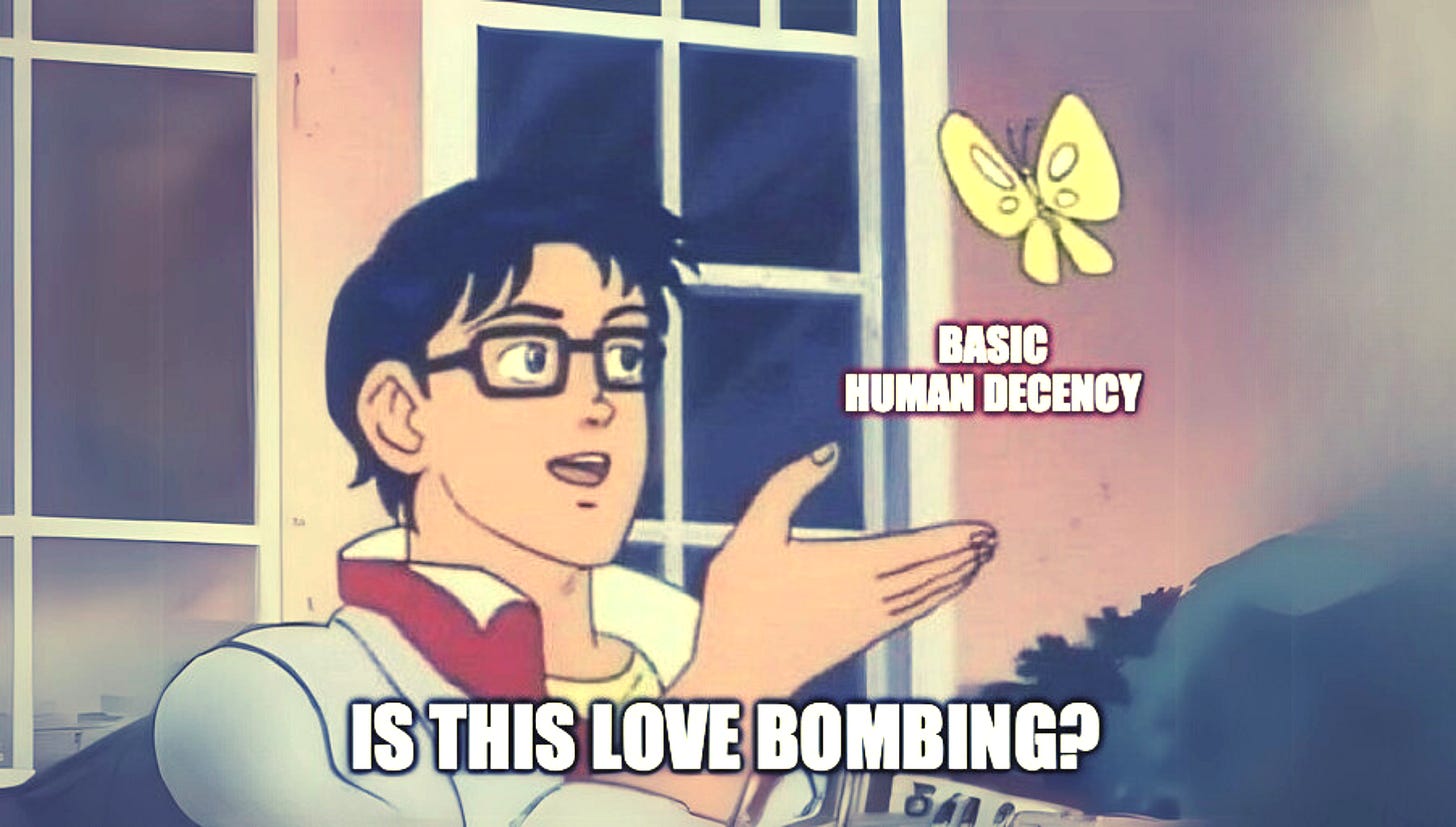How to Look for Red Flags
If you're wearing rose-colored glasses, everything looks like a red flag.
I wish it were as easy as giving you a list of red flags to look out for:
He still lives with his mom
He’s broke
He only has three shirts
He does drugs
He has unfashionable political opinions
He doesn’t have a job
He works too much
He has kids
He hates dogs
He has an illness
He has a mental illness
This way, if he has enough flags, you can dump the guy and feel good, and if he doesn’t have anything on the list, everything is great, right?
It gets more complicated than just having a list, and when enough items on the list are checked off, you should bounce.
This method leaves too much room for both false negatives (you’re ruling out good guys) as well as false positives (you didn’t vet for what actually matters, and so you ended up with someone who hurts you).
If you're wearing rose-colored glasses, everything looks like a red flag.
Also, if you’re wearing rose-colored glasses, the red flags just look like flags.
Which is true?
It is still tricky even when you adjust your red flags list to include not characteristics, but seemingly bad personal or possibly toxic behavior:
He is love bombing
He texts too much
He has a history of cheating
He has a history of lying
He has a gambling addiction
He has stolen money
He has a history with younger women
He watches porn
He doesn’t make plans with you
He makes too many plans with you
Some of these are clear signals that certain bad behavior is persistent and may harm you, but some of these are not so clear-cut. Is seeing a therapist good or bad? Is caring too much good or bad?
I generally think it is better to look at people as wholes rather than a collection of attributes, and try to interpret the things that could be flags through your interpretation of the person as a whole. Then, if it starts to look like something doesn't add up, you can start brainstorming ways to get more relevant information.
There aren't general rules for a lot of these things. You need to understand the context of the behavior to know what it means.
And if you feel good in your body and clear with your boundaries, then it's ok to take some time to figure out what information is crucial for deciding whether you want to stay together or pursue something deeper.
I find some of these questions to actually be advanced questions. Everybody these days has a sexuality and a past. People do all kinds of things with porn and social media. People have all kinds of personal boundaries with younger people, and different ways of enforcing them. People can pull back out of fear, or lean in out of excitement at finding a connection.
It can be tricky because one person can do things very playfully, shallowly, with a healthy, non-imposing, consensual sexuality, and another person can do the exact same things in super predatory ways.
Getting a larger picture by figuring out what a person wants out of life, what a person wants out of you specifically, and what a person is or isn’t willing to do to keep you happy or safe becomes important in understanding what a person is actually doing in any given event.
BEGIN BY GATHERING INFORMATION
The conventional framing of “looking for red flags,” almost always means one of two things.
Looking for dead-ends that eliminate a person from being somebody who you want to do something really deep and serious with (marriage).
Looking for clues that going slightly deeper with a person, even in casual dating, may lead to excessive drama, emotional harm, or physical harm to you.
It is important to keep these two untangled. I would use the phrase “dead-ends” to refer to deal breakers for a marriage for myself, even though that person may be a lovely person for somebody else with different preferences than me. I would use the phrase “red flags” to refer to characteristics that I consider unsafe for myself or others, even in a more casual situation.
I would start by identifying which situation you are in (looking for dead-ends or red flags), and then gather information to understand both what the other person is doing and what you are reacting to before determining a course of action.
DEAD-ENDS
A dead-end for marriage varies widely between individuals. One woman may not mind a man who already has kids, but for somebody else, this is a dealbreaker for the kind of marriage she wants. One woman may not mind a man who smokes (she might even find it hot), but for another woman this may be a big problem (a daily reminder that her man does not love her enough to stop sabotaging his health). One woman may love a man with a very high sex drive, but for another woman this counts as excessive drama.
It is important to remember that one man’s trash is another man’s treasure. Common often-opposite traits may include:
Which of these traits are “ideal to have” and which are “dead-ends” varies widely between individuals.
With the dead ends, I would emphasize meditating on the qualities you would like in your life. Would you enjoy a person who is near you a lot, or are you happy with more space? Would you enjoy the company of a person you can have certain kinds of intense conversations with, or somebody who keeps things safe and light? Do you want somebody who would join you on hikes, cooking adventures, and board games, or do you want to live with somebody who would stay out at the club with you?
Thinking about what qualities you want in your life will help you figure out what trade-offs make sense for you to prioritize. What kinds of things do you respect and enjoy in a person as a friend, but would not find fulfilling in a life partner? What traits in a life partner would help you build the life you want to live?
RED FLAGS
If you feel worried about missing a red flag, I would recommend checking in with your boundaries more generally. What situations do you really want to avoid? How have your boundaries been crossed before, that you want to avoid happening again? Are there ways of being unsafe that you want to be on the lookout for, specifically? What would make an encounter feel like a waste of time, or worse—what would make an encounter feel like it took something important away from you?
This way you are not relying on a list of generalized “red flags,” but are rather creating systems for evaluating if a a situation is a situation that you want to be in.
Different people can handle different kinds of unsafety, and so even if I made a generalized list of possible unsafeties, each person would have a priority list within that list. Some people can’t be in a smoke-filled room. Some people do not know how to handle somebody who is too forward. Some people do not know how to handle somebody who is too shy! Some people do not trust themselves in situations with alcohol. Some people do not feel safe unless there is a little bit of alcohol.
In this way, the red flags are not universal, but rather personalized to what you yourself either feel yourself capable of dealing with, or feel like dealing with at any given time.
Insofar as people get hurt by different things and have different capacities to handle different situations, you may want to take an honest inventory of your strengths and vulnerabilities.
What kinds of situations are you unusually good at handling? What, were it to happen, would make you wish you didn’t go out that night? What kinds of pressure are you better and worse at dealing with? What kinds of things do you tend not to notice, even though they might not be safe for you? What kinds of harms are you basically immune to, but then you may not notice when it boils beyond a level you can handle and so you need special guards?
Here is an incomplete, tentative list of potentially unsafe encounters. The way I would use this list is to note which situations you feel competent and confident in handling, and which situations would feel particularly frightening. I would then use a notebook to brainstorm additional bullet points for both, using this list as a starting inspiration.
A situation you do not want to be in may involve…
A person who asks things of you explicitly or boldly if you do not feel confident in your ability to say no.
A person who blatantly ignores your need for something to happen before another thing can happen, and then proceeds with the second thing without the prerequisites.
A person who is not clear about what they want and leaves you confused, and thus leaves you in psychological limbo for a week before they talk to you about it.
A person who is too shy to say what they want, and so you are never sure if you are crossing a line with them.
A person who regularly says one thing, but actually means something else and expects you to catch it.
A person who lies.
A person who assumes you will be responsible for the group’s safety.
A person who assumes they are single-handedly responsible for safety, and does not consider input from others.
A person who is pushy about you doing drugs with them.
A person who is pushy about you giving them drugs.
A person who expects you to spend money in ways you are not comfortable with.
A person who does not pay you back money that they owe you, which you need.
A person who does not respect your dietary restrictions.
A person who does not respect a boundary around a condition you have.
Note that the emphasis of this list is on situations to avoid, rather than on specific character traits of individuals to avoid.
If an individual frequently puts others in unsafe situations, I would consider them an unsafe person. However, most normal people do things that some person would consider unsafe some of the time. Therefore, I tend to observe a person’s patterns of behavior, rather than one-off-instances, before marking a person as having red flags in their personality.
There are people who can handle everything on this list without a scratch, and people who can handle none of these without a scratch, and every combination under the sun. Handling these is not just a matter of toughness, but also experience, flexibility, and awareness to catch problems early. Handling unpleasant situations is often annoying, and even though a catastrophe is prevented, it still takes a toll on the person who handled it.
One reminder is that calling somebody out for being unsafe, depending on the context, may not actually lead to more safety (short-term or long-term), and so reliance on this method of dealing with danger is not advised. It is advised to truthfully assess your level of being able to handle different situations, and to train your discernment.
TIPS AND TRICKS
For the purpose of vocabulary, you can think of your boundaries as, things you'd be hurt if they got crossed. You can think of limits as farther out, such that if those get crossed you have some buffer for hurt that happens to you.
Then you can evaluate how people treat your limits: if they respect them and are accommodating, or if they treat them as unimportant. If a person is rough with your limits, they are likely to be rough with your boundaries, too, when it is consequential and matters.




